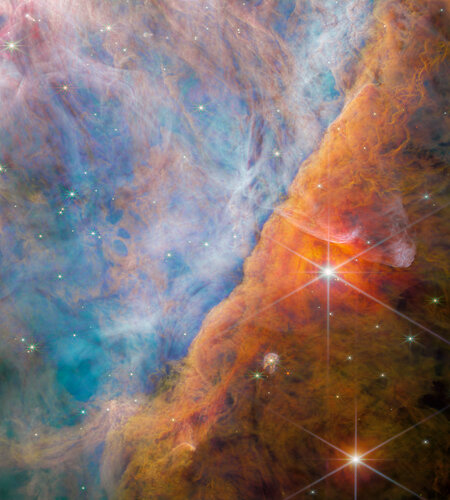

Open Image
Although research published as early as the 1970s predicted the importance of CH3+, it has previously been virtually impossible to detect. Many molecules in protoplanetary discs are observed using radio telescopes. However, for this to be possible the molecules in question need to possess what is known as a ‘permanent dipole moment’, meaning that the molecule’s geometry is such that its electric charge is permanently off balance, giving the molecule a positive and a negative ‘end’. CH3+ is symmetrical, and therefore its charge is balanced, and so lacks the permanent dipole moment necessary for observations with radio telescopes. It would theoretically be possible to observe spectroscopic lines emitted by CH3+ in the infrared, but the Earth’s atmosphere makes these essentially impossible to observe from Earth. Thus, it was necessary to use a sufficiently sensitive space-based telescope that could observe signals in the infrared. The instruments NIRSpec, part of the European contribution to Webb’s, and MIRI, half of which was contributed by Europe, were perfect for the job. In fact, a CH3+ detection had previously been so elusive that when the team first saw the signal in their data, they were not sure how to identify it. Remarkably, the team were able to interpret their result within four short weeks, by drawing on the expertise of an international team with a varied range of expertise.
The discovery of CH3+ was possible only through a collaboration among observational astronomers, astrochemical modellers, theoreticians, and experimental spectroscopists, which combined the unique capabilities of JWST in space with those of Earth-based laboratories in order to successfully investigate and interpret our local universe’s composition and evolution. Marie-Aline Martin adds: “Our discovery was only made possible because astronomers, modellers, and laboratory spectroscopists joined forces to understand the unique features observed by James Webb.”
The PDRs4ALL ERS team's results have been published today in Nature.
Notes
[1] A molecule is a particle made up of two or more atoms that are held together by chemical bonds.
[2] A compound is a molecule that includes more than one element. Thus, all compounds are molecules but not all molecules are compounds. As an example, the hydrogen molecule (H2) is a molecule but not a compound, whereas the water molecule (H2O) is also a compound.
[3] Organic chemistry refers to the chemistry of carbon-based molecules and compounds. It may also be referred to as carbon chemistry.
[4] An ion is an atom or molecule that has an overall electrical charge, due to an excess or deficit in the number of negative electrons compared to the number of positive protons in the ion. A cation is an ion with a net positive charge (so a deficit of electrons).
[5] A complex organic molecule is a molecule with multiple carbon atoms.
[6] A protoplanetary disc is a rotating disc of gas and dust that forms around young stars, and from which planets can ultimately form.
More information
Webb is the largest, most powerful telescope ever launched into space. Under an international collaboration agreement, ESA provided the telescope’s launch service, using the Ariane 5 launch vehicle. Working with partners, ESA was responsible for the development and qualification of Ariane 5 adaptations for the Webb mission and for the procurement of the launch service by Arianespace. ESA also provided the workhorse spectrograph NIRSpec and 50% of the mid-infrared instrument MIRI, which was designed and built by a consortium of nationally funded European Institutes (The MIRI European Consortium) in partnership with JPL and the University of Arizona.
Webb is an international partnership between NASA, ESA and the Canadian Space Agency (CSA).
Contact:
ESA Media relations



